Sean Jacobs's Blog, page 503
December 31, 2012
On Safari

We are taking a collective break from blogging until Thursday, January 10th to give us a chance to breathe and catch up with our lives. Till then feel free to read our rich archive of posts from 2012, check in with our “Best …”-lists below and follow us on Facebook and Twitter where we may post occasionally in the interim. Happy New Year!

Our Favorite Books of 2012
 Ronelda Kamfer’s Grond/Santekraam (originally published in Afrikaans in 2011; superbly translated into Dutch by Alfred Schaffer and published by Podium as Santenkraam in 2012) is her second collection of poems. A moving tribute to her family’s history and, specifically, the inspiring story-telling of her late grandfather, we get to know the history of the fishing village of Skipskop through the many voices of some its inhabitants. In a recent interview Kamfer said that as a young girl she would have loved to read her history in the form of a novel and that she hopes her poetry will get people to record their memories. “Apartheid somehow took those away from them.” Give Grond/Santekraam an English, French or an Arabic translation, and Kamfer’s name will travel far and wide. That translation will be no easy task though. Talking about translations, and as an honorable mention, will the non-francophone world get to read Sabri Louatah’s Les Sauvages next year? Below are 10 more AIAC contributors’ favorites:
Ronelda Kamfer’s Grond/Santekraam (originally published in Afrikaans in 2011; superbly translated into Dutch by Alfred Schaffer and published by Podium as Santenkraam in 2012) is her second collection of poems. A moving tribute to her family’s history and, specifically, the inspiring story-telling of her late grandfather, we get to know the history of the fishing village of Skipskop through the many voices of some its inhabitants. In a recent interview Kamfer said that as a young girl she would have loved to read her history in the form of a novel and that she hopes her poetry will get people to record their memories. “Apartheid somehow took those away from them.” Give Grond/Santekraam an English, French or an Arabic translation, and Kamfer’s name will travel far and wide. That translation will be no easy task though. Talking about translations, and as an honorable mention, will the non-francophone world get to read Sabri Louatah’s Les Sauvages next year? Below are 10 more AIAC contributors’ favorites:  Gabrielle Hecht’s book Being Nuclear: Africans and the Global Uranium Trade (MIT Press, 2012) looks at the history of what she calls “nuclearity” — how some things and practices become designated as nuclear and others not. She observes that “standing in an African uranium mine makes the contingent character of nuclearity much more visible” (13). Gathering vast materials (sometimes rescuing, although she’s all humility on this count) — 50,000 pages of documents from colonial, state, and company archives and 138 interviews — from numerous countries, and interspersing incisive comparative material from other places (Navajo reservations, for example), Hecht shows how states (colonial and independent) and institutions have worked to, in her words, “banalize” and “exceptionalize” uranium production to create a world uranium market, to claim or deny nuclear status (like apartheid South Africa’s claim to a seat on the IAEA but denial of radiation exposure of black workers in mines), and to negotiate the political and economic transitions of decolonization. Looking at particular histories from Niger, Gabon, Namibia, South Africa, and Madagascar Hecht writes about entangled histories, exposing the workings of power through technopolitics, without predictable narratives. [Marissa Moorman]
Gabrielle Hecht’s book Being Nuclear: Africans and the Global Uranium Trade (MIT Press, 2012) looks at the history of what she calls “nuclearity” — how some things and practices become designated as nuclear and others not. She observes that “standing in an African uranium mine makes the contingent character of nuclearity much more visible” (13). Gathering vast materials (sometimes rescuing, although she’s all humility on this count) — 50,000 pages of documents from colonial, state, and company archives and 138 interviews — from numerous countries, and interspersing incisive comparative material from other places (Navajo reservations, for example), Hecht shows how states (colonial and independent) and institutions have worked to, in her words, “banalize” and “exceptionalize” uranium production to create a world uranium market, to claim or deny nuclear status (like apartheid South Africa’s claim to a seat on the IAEA but denial of radiation exposure of black workers in mines), and to negotiate the political and economic transitions of decolonization. Looking at particular histories from Niger, Gabon, Namibia, South Africa, and Madagascar Hecht writes about entangled histories, exposing the workings of power through technopolitics, without predictable narratives. [Marissa Moorman] I really, really enjoyed Nadine Gordimer’s No Time Like the Present. It is a complicated story of relationships, hope, and the day to day realities of aspiration and disappointment in post-apartheid South Africa. Gordimer’s focus on the immediate, personal spaces of the interracial couple she follows for the two decades of life after apartheid documents the end of the Mandela era, the dismissal of Mbeki, and the incredibly complex and contradictory forces that dictate both the political and personal in the Zuma era. Gordimer continues to be in top form. Honorable mention: I’d also recommend Michael Mahoney’s The Other Zulus: The Spread of Zulu Ethnicity in Colonial South Africa (Duke University Press, 2012) for my favorite academic African Studies book this year. Fantastic work on the development of Zulu identity throughout the nineteenth and early twentieth century. [T.J. Tallie]
I really, really enjoyed Nadine Gordimer’s No Time Like the Present. It is a complicated story of relationships, hope, and the day to day realities of aspiration and disappointment in post-apartheid South Africa. Gordimer’s focus on the immediate, personal spaces of the interracial couple she follows for the two decades of life after apartheid documents the end of the Mandela era, the dismissal of Mbeki, and the incredibly complex and contradictory forces that dictate both the political and personal in the Zuma era. Gordimer continues to be in top form. Honorable mention: I’d also recommend Michael Mahoney’s The Other Zulus: The Spread of Zulu Ethnicity in Colonial South Africa (Duke University Press, 2012) for my favorite academic African Studies book this year. Fantastic work on the development of Zulu identity throughout the nineteenth and early twentieth century. [T.J. Tallie] No book captures 21st century Southern Africa’s place in the world order better than Julie Livingston’s Improvising Medicine: An African Oncology Ward in an Emerging Cancer Epidemic (Duke University Press, 2012). Livingston’s first-rate ethnography brings her readers inside Botswana’s only cancer ward, where doctors, nurses and patients struggle with cancer. The book is a readable and passionately humane account of the political economy of health in the 21st century, and will change how you think about the social experience of pain and healing in the contemporary world. [Dan Magaziner]
No book captures 21st century Southern Africa’s place in the world order better than Julie Livingston’s Improvising Medicine: An African Oncology Ward in an Emerging Cancer Epidemic (Duke University Press, 2012). Livingston’s first-rate ethnography brings her readers inside Botswana’s only cancer ward, where doctors, nurses and patients struggle with cancer. The book is a readable and passionately humane account of the political economy of health in the 21st century, and will change how you think about the social experience of pain and healing in the contemporary world. [Dan Magaziner] I thoroughly enjoyed London Recruits: The Secret War Against Apartheid (Merlin Press, 2012), compiled and edited by Ken Keable, a collection of first hand accounts by white activists — mainly English Communists — who were recruited in the 1960s/70s by the African National Congress/South African Communist Party to travel to South Africa posing as tourists to covertly disseminate anti-apartheid propaganda in the form of leaflet “bombs,” tape recorded messages from the exiled leadership, etc. A truly inspiring story of multi-racial, trans-national solidarity. [Dennis Laumann]
I thoroughly enjoyed London Recruits: The Secret War Against Apartheid (Merlin Press, 2012), compiled and edited by Ken Keable, a collection of first hand accounts by white activists — mainly English Communists — who were recruited in the 1960s/70s by the African National Congress/South African Communist Party to travel to South Africa posing as tourists to covertly disseminate anti-apartheid propaganda in the form of leaflet “bombs,” tape recorded messages from the exiled leadership, etc. A truly inspiring story of multi-racial, trans-national solidarity. [Dennis Laumann]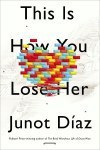 This is How You Lose Her is Junot Diaz’s second book of short stories. He debuted with another collection, Drown, in the 1990s and a few years ago wrote the novel The Brief Wondrous Life of Oscar Wao. I’m still looking for someone to write about Cape Town’s working classes (where I grew up) in the same way Diaz writes about the worlds of Dominican immigrants in America. Honorable mentions: I am currently reading journalist professor Doug Foster’s After Mandela (I’ll write a review in the new year) and so far, this book which is really about a group of young South Africans, is quite good. Finally, I enjoyed reviewing the sixth (and final?) volume of the “From Protest to Challenge” series (full title: From Protest to Challenge: a Documentary History of African Politics in South Africa, 1882–1990, Volume 6, Challenge and Victory 1980–1990). [Sean Jacobs]
This is How You Lose Her is Junot Diaz’s second book of short stories. He debuted with another collection, Drown, in the 1990s and a few years ago wrote the novel The Brief Wondrous Life of Oscar Wao. I’m still looking for someone to write about Cape Town’s working classes (where I grew up) in the same way Diaz writes about the worlds of Dominican immigrants in America. Honorable mentions: I am currently reading journalist professor Doug Foster’s After Mandela (I’ll write a review in the new year) and so far, this book which is really about a group of young South Africans, is quite good. Finally, I enjoyed reviewing the sixth (and final?) volume of the “From Protest to Challenge” series (full title: From Protest to Challenge: a Documentary History of African Politics in South Africa, 1882–1990, Volume 6, Challenge and Victory 1980–1990). [Sean Jacobs] I really enjoyed José Eduardo Agualusa’s My Father’s Wives this year. Its not new (originally published in 2007 as As Mulheres do Meu Pai) but it is/was a really ambitious translation project (the nearly 400 pages were translated in 2008 by Daniel Hahn) and it deserves a wide audience. Quarterly Conversations did a longer profile when it came out. Agualusa’s commitment to form brings out fresh insights into travel and movement: unexpected compromises between domesticity and stability. [Megan Eardley]
I really enjoyed José Eduardo Agualusa’s My Father’s Wives this year. Its not new (originally published in 2007 as As Mulheres do Meu Pai) but it is/was a really ambitious translation project (the nearly 400 pages were translated in 2008 by Daniel Hahn) and it deserves a wide audience. Quarterly Conversations did a longer profile when it came out. Agualusa’s commitment to form brings out fresh insights into travel and movement: unexpected compromises between domesticity and stability. [Megan Eardley] Walter Rodney’s classic How Europe Underdeveloped Africa turned 40 this year. And though it has been significantly and quite successfully challenged over the decades, its importance to the re-orientation of African political-economy and historiography away from narrow nationalist and Eurocentric developmentalism to a broader critique of colonial and capitalist development deserves celebration. Honorable mention: One Hundred Years of the ANC: Debating Liberation Histories Today (Wits University Press, 2012), edited by Arianna Lissoni, Jon Soske, Natasha Erlank, Noor Nieftagodien and Omar Badsha (full disclosure: Soske’s a dear friend). In the context of a negotiated settlement, victory, and thus history, is uncertain. In many respects, South Africa’s ‘post-apartheid’ dominant narrative is decidedly anti-ANC as various voices conspire to produce a version of what their counter-discourse would suppose the ANC narrative to be. Whether by default or design, this collection contributes to the understanding of on-going contestation over the past for futures yet to be scribed. [Melissa Levin]
Walter Rodney’s classic How Europe Underdeveloped Africa turned 40 this year. And though it has been significantly and quite successfully challenged over the decades, its importance to the re-orientation of African political-economy and historiography away from narrow nationalist and Eurocentric developmentalism to a broader critique of colonial and capitalist development deserves celebration. Honorable mention: One Hundred Years of the ANC: Debating Liberation Histories Today (Wits University Press, 2012), edited by Arianna Lissoni, Jon Soske, Natasha Erlank, Noor Nieftagodien and Omar Badsha (full disclosure: Soske’s a dear friend). In the context of a negotiated settlement, victory, and thus history, is uncertain. In many respects, South Africa’s ‘post-apartheid’ dominant narrative is decidedly anti-ANC as various voices conspire to produce a version of what their counter-discourse would suppose the ANC narrative to be. Whether by default or design, this collection contributes to the understanding of on-going contestation over the past for futures yet to be scribed. [Melissa Levin]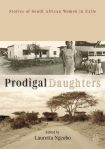 Prodigal Daughters: Stories of South African Women in Exile (UKZN Press, 2012), edited by Lauretta Ngcobo is a collection of seventeen stories by ANC and PAC women; these are parts of the struggle years that one hardly ever hears about in the official record. Most of the women fled to avoid imprisonment, children behind with families, and ended up living as exiles in the Frontline states — Lesotho, Swaziland, Zimbabwe, and Botswana. Then women who end up in Algeria find that they are constantly followed by men; one woman chased a man down the street after he followed her to the door of ANC offices. In Botswana, many women were shocked to find that they would be “interrogated and photographed like criminals,” writes Carmel Chetty. In Zambia, Ngcobo finds that she is not accepted as a bona fide PAC member — because only men supposedly join the struggle. When she and the other women exiles form a women’s group, raising funds to help support their families, their team gets “summoned to the PAC office in Lusaka,” where they were told that they must “submit all the documents of the PAC women’s organization,” the bank records in particular. And then, the Zambians do a Nigerian email scam: “Those men took all the books, went and withdrew all the money from the bank… Yes, that ended the dream of supporting women on the home front.” [Neelika Jayawardane]
Prodigal Daughters: Stories of South African Women in Exile (UKZN Press, 2012), edited by Lauretta Ngcobo is a collection of seventeen stories by ANC and PAC women; these are parts of the struggle years that one hardly ever hears about in the official record. Most of the women fled to avoid imprisonment, children behind with families, and ended up living as exiles in the Frontline states — Lesotho, Swaziland, Zimbabwe, and Botswana. Then women who end up in Algeria find that they are constantly followed by men; one woman chased a man down the street after he followed her to the door of ANC offices. In Botswana, many women were shocked to find that they would be “interrogated and photographed like criminals,” writes Carmel Chetty. In Zambia, Ngcobo finds that she is not accepted as a bona fide PAC member — because only men supposedly join the struggle. When she and the other women exiles form a women’s group, raising funds to help support their families, their team gets “summoned to the PAC office in Lusaka,” where they were told that they must “submit all the documents of the PAC women’s organization,” the bank records in particular. And then, the Zambians do a Nigerian email scam: “Those men took all the books, went and withdrew all the money from the bank… Yes, that ended the dream of supporting women on the home front.” [Neelika Jayawardane] Sarah LeFanu’s S is for Samora. A Lexical Biography of Samora Machel and the Mozambican Dream (UKZN Press, 2012) is a highly readable, informative and entertaining guide of the life and times of Mozambique’s revolutionary leader and first President Samora Moises Machel. LeFanu was one of the many young enthusiasts from the West who had sympathised with the struggle for liberation of the people of Mozambique and she travelled there in the 1970s post-independence to work as a volunteer or cooperante during reconstruction as a socialist country. It is then also a bit of a memoir, as she returned back in 2008 to revisit acquaintances and refresh her memories of those difficult but also rewarding times. A must read for those interested in the revolutionary history of Southern Africa. (With warm thanks to Percy Zvomuya for a wonderful Christmas gift.) [Thomas Blaser]
Sarah LeFanu’s S is for Samora. A Lexical Biography of Samora Machel and the Mozambican Dream (UKZN Press, 2012) is a highly readable, informative and entertaining guide of the life and times of Mozambique’s revolutionary leader and first President Samora Moises Machel. LeFanu was one of the many young enthusiasts from the West who had sympathised with the struggle for liberation of the people of Mozambique and she travelled there in the 1970s post-independence to work as a volunteer or cooperante during reconstruction as a socialist country. It is then also a bit of a memoir, as she returned back in 2008 to revisit acquaintances and refresh her memories of those difficult but also rewarding times. A must read for those interested in the revolutionary history of Southern Africa. (With warm thanks to Percy Zvomuya for a wonderful Christmas gift.) [Thomas Blaser] Driven by narrator Adam Raven’s investigation into the murder of Taxi Poet Solly Greenfield, Imraan Coovadia’s fourth book, The Institute of Taxi Poetry (Umuzi, 2012), is a inimitable mash-up between detective genre, prose poetry, and satire designed to challenge the easy script of a South African literature that too often falls back on familiar racial melodramas. It introduces us to a fantastic industry, the art of taxi poetry, and then asks us to imagine how this world would operate in a Lusophone South Africa where a different colonial legacy was in play. Internationalist gangsters, uncompromisingly idealistic young taxi poets, sclerotic academics, and out-of-step revolutionaries cross path, creating a literary world almost fantastic enough to capture Cape Town’s sheer improbability. [Jon Soske]
Driven by narrator Adam Raven’s investigation into the murder of Taxi Poet Solly Greenfield, Imraan Coovadia’s fourth book, The Institute of Taxi Poetry (Umuzi, 2012), is a inimitable mash-up between detective genre, prose poetry, and satire designed to challenge the easy script of a South African literature that too often falls back on familiar racial melodramas. It introduces us to a fantastic industry, the art of taxi poetry, and then asks us to imagine how this world would operate in a Lusophone South Africa where a different colonial legacy was in play. Internationalist gangsters, uncompromisingly idealistic young taxi poets, sclerotic academics, and out-of-step revolutionaries cross path, creating a literary world almost fantastic enough to capture Cape Town’s sheer improbability. [Jon Soske]

2012′s SMH (also known as “Africa is a Country”) Moments
 There are times we shake our heads or roll our eyes. When we could not invent some of the things that we spot in the media. For some reason especially New York Times journalists can’t help themselves (though there are some exceptions like Lydia Polgreen reporting from Johannesburg). For example, former Times editor Bill Keller is currently in South Africa and even when meaning well, he misses the point. Then there’s Nicholas Kristof (who we swore we won’t blog about again) and Jeffrey Gettleman, who nominated himself for a journalism prize (more below). But the one person who will play a bigger role in shaping coverage of Africa (for people who don’t read news pages) is the force that is Suzy Menkes. If you don’t know her, she writes about “global” fashion and sort of cultural politics for the Times. She is singlehandedly keeping Bono and his wife Ali’s fashion business, Edin, in the news. Siddhartha Mitter storified her pronouncements and if you want to put yourself through her editorializing about “ethical fashion” and helping Africa (especially “Kin-yaa”) “through style and design,” just read her pieces in the Times. Bonus: she also thinks Africa is a country. Watch this video (with Bono and Ali again as well as with Renzo Diesel) where Menkes refers to “helping the African nation and people” (about 7:30 mark).
There are times we shake our heads or roll our eyes. When we could not invent some of the things that we spot in the media. For some reason especially New York Times journalists can’t help themselves (though there are some exceptions like Lydia Polgreen reporting from Johannesburg). For example, former Times editor Bill Keller is currently in South Africa and even when meaning well, he misses the point. Then there’s Nicholas Kristof (who we swore we won’t blog about again) and Jeffrey Gettleman, who nominated himself for a journalism prize (more below). But the one person who will play a bigger role in shaping coverage of Africa (for people who don’t read news pages) is the force that is Suzy Menkes. If you don’t know her, she writes about “global” fashion and sort of cultural politics for the Times. She is singlehandedly keeping Bono and his wife Ali’s fashion business, Edin, in the news. Siddhartha Mitter storified her pronouncements and if you want to put yourself through her editorializing about “ethical fashion” and helping Africa (especially “Kin-yaa”) “through style and design,” just read her pieces in the Times. Bonus: she also thinks Africa is a country. Watch this video (with Bono and Ali again as well as with Renzo Diesel) where Menkes refers to “helping the African nation and people” (about 7:30 mark).
Then there’s American rapper (and entrepreneur) 50 Cent. In February this year he (accompanied by praise-singing American journalists) went to Somalia and Kenya and concluded Africa’s refugees needed mineral water; more recently he decided to make a song (sample lyrics: “… finna end world hunger, goddamn”) about that experience and to promote his new ear phones range. Here’s the bizarre video (that was broken down by Derica Shields over at Okayafrica when it came out earlier this month).
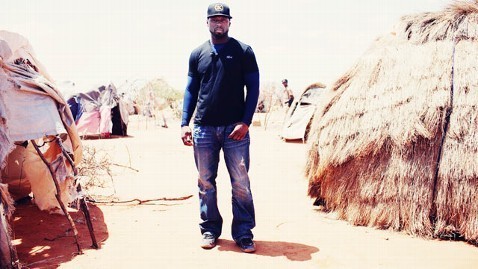 Then there was everything about #Kony2012, which was bigger than 50 Cent. Everyone wanted a piece of that. Even Soulja Boy wanted to get at Joseph Kony. We wrote a lot about it. The best of our bunch was Elliot’s post. And Zach Rosen broke down what that was all about in a post last week. So I am not going to rehash all that here.
Then there was everything about #Kony2012, which was bigger than 50 Cent. Everyone wanted a piece of that. Even Soulja Boy wanted to get at Joseph Kony. We wrote a lot about it. The best of our bunch was Elliot’s post. And Zach Rosen broke down what that was all about in a post last week. So I am not going to rehash all that here.
An American lawyer sent me (and it seems a few other African and Africanist academics in the US) an email to testify on behalf of “a family of white Afrikaner farmers who are seeking asylum and withholding of removal based on allegations that they are the victims of discrimination based on their race and political affiliation.”
The sideshow and bad reporting around a t-shirt “I benefited from Apartheid” to be worn exclusively by white South Africans. It even made it onto Canadian public radio (forward to the 4:00 mark). Check out our Facebook page for a spirited debate.
 In early November the New York Times Magazine ran a cover story on the Oklahoma Thunder. The cover features the team’s four stars — Russell Westbrook, Thabo Sefolosha, Kevin Durant and Serge Ibaka (who we’ve blogged about here before). The piece, however, is really about Durant (it’s boilerplate American journalism on black sports stars). Ibaka (below) is reduced to these lines in a caption: “Serge Ibaka’s first coach, in Congo, taught him using a water bottle.” They also didn’t tell us which Congo.
In early November the New York Times Magazine ran a cover story on the Oklahoma Thunder. The cover features the team’s four stars — Russell Westbrook, Thabo Sefolosha, Kevin Durant and Serge Ibaka (who we’ve blogged about here before). The piece, however, is really about Durant (it’s boilerplate American journalism on black sports stars). Ibaka (below) is reduced to these lines in a caption: “Serge Ibaka’s first coach, in Congo, taught him using a water bottle.” They also didn’t tell us which Congo.
 Then Vogue Italia decided to “rebrand Africa” in one of those “Africa” issues that every major Western popular publication feels obligated to bring out. They put UN secretary-general Ban Ki-Moon on the cover. Franca Sozzani, editor of Vogue Italia, decides to give some free advice to Nigeria’s President Goodluck Jonathan: “All the richest Nigerians spend their money abroad because there are no shops here, no hotels with a chic African flair, no hip restaurants or clubs. Why not build an African Rodeo Drive in Lagos or Abuja, with boutiques carrying both imported and Nigerian goods?” It all went downhill from there as Elliot Ross reminded us at the time.
Then Vogue Italia decided to “rebrand Africa” in one of those “Africa” issues that every major Western popular publication feels obligated to bring out. They put UN secretary-general Ban Ki-Moon on the cover. Franca Sozzani, editor of Vogue Italia, decides to give some free advice to Nigeria’s President Goodluck Jonathan: “All the richest Nigerians spend their money abroad because there are no shops here, no hotels with a chic African flair, no hip restaurants or clubs. Why not build an African Rodeo Drive in Lagos or Abuja, with boutiques carrying both imported and Nigerian goods?” It all went downhill from there as Elliot Ross reminded us at the time.
 South African director Darrell Roodt premiered a re-cut version of his terrible film “Winnie” with Jennifer Hudson and Terrence Howard. Again, no one was impressed.
South African director Darrell Roodt premiered a re-cut version of his terrible film “Winnie” with Jennifer Hudson and Terrence Howard. Again, no one was impressed.
 Rick Ross went and shot a video in Lagos, Nigeria. I forced myself to watch it for you. Here’s a screenshot.
Rick Ross went and shot a video in Lagos, Nigeria. I forced myself to watch it for you. Here’s a screenshot.
 Chester Hanks, the son of actor Tom Hanks and rapper (yes he is), toured “Africa” with his family this past summer (not clear whether they’re still there). On August 4th, Hanks (rapper name Chet Haze) tweeted: “Africa is so beautiful! Everyone MUST visit at least one time in their life!” He did not tell us what country. Chet also tweeted this picture below of him in the house where he stays (with its colonial fantasy decor). Chester Hanks goes to Northwestern University in Chicago’s northern suburbs (I’m an alumn). What are they teaching students there these days?
Chester Hanks, the son of actor Tom Hanks and rapper (yes he is), toured “Africa” with his family this past summer (not clear whether they’re still there). On August 4th, Hanks (rapper name Chet Haze) tweeted: “Africa is so beautiful! Everyone MUST visit at least one time in their life!” He did not tell us what country. Chet also tweeted this picture below of him in the house where he stays (with its colonial fantasy decor). Chester Hanks goes to Northwestern University in Chicago’s northern suburbs (I’m an alumn). What are they teaching students there these days?

Finally, here’s a list of Honorable Mentions:
In January fashion designer Michael Kors came up with a “Safari” look; a white South African (who else and where else) decided he’d live as Tarzan; there was the viagra politics of South Africa’s Democratic Alliance (later exposed to be cut and paste too); a Belgian charity supports “unborn African babies;” the South African comedian Trevor Noah decided it was cool to get laughs at African Americans’ expense on the Jay Leno Show; a few people got mad that Thandi Newton is playing an Igbo woman in a film about the Biafran War; the reality stars of Bravo’s “The Real Housewives of Atlanta” decided to travel to South Africa (as one of them, Kandi, quipped: “When I think of Africa, I just think of … Naked women with their breasts out”); and the Huffington Post decided to play travel agent on “the world’s worst places” (sample: Mogadishu, “A soulless place at the edge of Africa… Oddly enough, several supermodels were born in Mogadishu”).
In February, we learned that for some odd reason the Financial Times still thought Ayaan Ali Hirsi and Dambisa Moyo make sense; about a US-based online search engine that makes excuses for Apartheid; we couldn’t keep count of every actor who has played Nelson Mandela in a Hollywood production (no South Africans need apply); rightwing (and a few “mainstream”) US commentators were affronted when Supreme Court Justice Ruth Bader Ginsberg praised the South African Constitution as a better standard than their own; and Tunisia’s new rulers (like they don’t have enough on their plates already) decided to prosecute journalists who republished the cover of German GQ featuring the German defender Sami Khedera and his girlfriend (she wears nothing).
In March, apart from #Kony2012 there were the cricket-playing Maasai; Oprah and Nicholas Kristof (they would not go away for the rest of the year); and Jeffrey Gettleman; some young South Africans thought they’d make one of those unfunny “Shit (Insert Target Here) Say …” videos; also in South Africa (what is it with the place?), a member of the Rupert clan decided to open a leather-goods store and came up with some questionable marketing; Ne-Yo announced he was also adopting African babies; basketball player Dikembe Mutombo (!) ran a gold mining sting; the American comedian Mike Epps decided to make cheap jokes at Nigerians’ expense; and Spanish goalkeeper Pepe Reina thought it was funny to star in an offensive ad (stereotypes about cannibalism in Africa) for a Spanish multinational insurance company (ah, the Spanish).
In April, the Guggenheim Foundation decides there’s no interesting art initiatives to link up with south of the Sahara; the BBC plays PR agent for Shell’s dismal record in Nigeria; Jeffrey Gettleman nominated himself for a Pulitzer Prize (and won!); and the branding of Africa continued (sample: Coco Cola Kenya).
May brought us BET introducing an “Africa” category to its Music Awards (let’s celebrate progress people); photographer Pieter Hugo getting mad at “political correctness” (basically people who have questions about his work); IMF President Christine Lagarde declaring how much she cares for villagers in Niger; an American singer, to quote Rihanna, “found love in a hopeless place,” i.e. Kenya; another invitation to save Africans by buying stuff, this time in Canada; and the (strategic) sideshow that was the penis of South Africa’s President Jacob Zuma (well, a drawing of it on a photocopied image of Vladimir Lenin’s body and Zuma’s face).
In June (the northern summer), we did not have time to blog much (we were on Twitter instead and I was traveling in South Africa), Denzel Washington’s CIA caper shot in Cape Town came out; and as usual South African fast food chain Nando’s continued their run of mixing bad politics with good chicken.
In July, Foreign Policy (the magazine birthed by Samuel Huntington) released its stupid, annual “Failed States Index,” in conjunction with something called the Fund for Peace, again; Chelsea defender John Terry, who goes around referring to black opponents as “black cunt,” used Africa as an alibi; Megan Eardley scoured the libraries and Amazon for “the best and worst romance, adventure, intrigue, and kinky fantasies Africa has to offer;” we blogged about the strange story of Ismael Sankara (is he Thomas’s son and does it matter?); Nicholas Kristof visited Lesotho; Maria Hengeveld upset some people with her post about “Afrigasms;” and we made lots of summer lists.
In August, everyone felt better (we like to think we matter) as we went on safari.
In September, Mos Def (Yasiin Bey) played a mbira; Kehinde Wiley went to Israel; and “Project Runway” imagined African fashion resembles the American South (we understand if they got confused, both places have lots of black people).
In October, we learned that some Kenyans want to pick their leaders via reality TV; Italian politicians like to threaten to move to Africa when they don’t like what an opponent thinks or say (we already know they love holidaying in Kenya); we noticed McDonald was selling black and African pride to appeal to African-Americans; and there was that “uproar” about the Finnish film of a World War II general shot in Kenya with an all-Kenyan cast; #Tintingate in Sweden; “W” Magazine went to Johannesburg and discovered last year’s trends; Deakin of the band Animal Collective convinced supporters to raise $26,000 for him to travel to Mali and “end slavery” and to make an album (no album yet if you wondering and he has not ended slavery); and Solange Knowles (Beyonce’s more talented sister) went to shoot a music video in Cape Town.
In November, TIME Magazine ran one of those irritating “Africa Rising” cover stories (that’s like a self-evident truth nowadays); Foreign Affairs (them again) covered a Bono (him again) speech in Washington DC; the French-Congolese rugby player Yannick Noah Nyanga cried while singing the French national anthem (French rightwingers were beside themselves); and the video game Call of Duty included a weird storyline about dead Angolan “rebel” leader (more like warlord) Jonas Savimbi.
And in December, in an allAfrica.com article (H/T Melissa Levin) emblazoned with the headline, “Africa: Preparing Youth for Africa as a Country”, Frannie Léautier, the executive secretary of the African Capacity Building Foundation (ACBF), claims that this is one of the most important lessons for the new generation. Léautier says that “as Africa continues to integrate it may become one big country”. This is a dream of the Development Set who suggest that size does indeed count (at least for countries when it comes to economic success). There has been much written about the problematic sustenance of the colonial borders of Africa. Amongst others, Paul Collier (in Wars, Guns, and Votes: Democracy in Dangerous Places) suggests that shrinking balkanized Africa to 7 states would do wonders for development. At least not one big country though….
* Thanks to Diego Gutierrez for the Africa is a Country logo.

December 28, 2012
10 Contested Images of 2012
 Remember that little video campaign called #Kony2012? Yeah, we wish we could forget too. Few videos have reached the magnitude of pestilence that the non-profit Invisible Children’s video achieved this year. By transforming a complex regional crisis involving the Lord’s Resistance Army into a simple, manufactured (and in some ways factually false) narrative about the forces of good and evil, Jason Russell and his team at Invisible Children mobilized overeager teenagers like never before. Sharing the Kony 2012 video on Facebook and Twitter became akin to saving vulnerable African children from certain abduction. Activism had never been so easy. Amidst the cauldron of outrage, shock and disappointment stirred by the Kony 2012 video, Glenna Gordon released the photo above that further damaged the efforts of Russell and Co. to appear serious and altruistic. Invisible Children tried to embrace the image, calling it a joke, but the damage was done. The furor caused by the video mutated into deeper scrutiny and critical backlash, exposing IC’s ties to evangelical Christian organizations and leading the heroic Russell to have his infamous breakdown.
Remember that little video campaign called #Kony2012? Yeah, we wish we could forget too. Few videos have reached the magnitude of pestilence that the non-profit Invisible Children’s video achieved this year. By transforming a complex regional crisis involving the Lord’s Resistance Army into a simple, manufactured (and in some ways factually false) narrative about the forces of good and evil, Jason Russell and his team at Invisible Children mobilized overeager teenagers like never before. Sharing the Kony 2012 video on Facebook and Twitter became akin to saving vulnerable African children from certain abduction. Activism had never been so easy. Amidst the cauldron of outrage, shock and disappointment stirred by the Kony 2012 video, Glenna Gordon released the photo above that further damaged the efforts of Russell and Co. to appear serious and altruistic. Invisible Children tried to embrace the image, calling it a joke, but the damage was done. The furor caused by the video mutated into deeper scrutiny and critical backlash, exposing IC’s ties to evangelical Christian organizations and leading the heroic Russell to have his infamous breakdown.
In April, Swedish artist Makode Linde decided to bake a cake for an exhibition commemorating the 75th anniversary of the Swedish Artists’ National Organization. Linde, however, neglected to mention to the exhibition’s organizers that his gollywog-style cake, crafted in the shape of a black body would be alive (with Linde himself inside it). As soon as the exhibition’s guest of honor, Swedish Culture Minister Lena Adelsohn Liljeroth, cut into the cake it began to wail loudly. Finding humor in the cake’s pained cries, the Culture Minister proceeded to feed the cake to itself, leading to this image by Marianne Lindberg De Geer.
 Few if any of the event’s guests seemed to be troubled by the writhing, shrieking cake and on the contrary many reveled in cutting slices for themselves. The Minister was soon accused of racial insensitivity by the National Afro-Swedish Association, which called for her resignation. An interview with Makode Linde later revealed that the cake was intended to be part of his “Afromantics” series on black identity and cultural representation in Sweden and not a trap intended solely for the Minister. Whatever the artist’s intention was, Lindberg De Geer’s image bears testimony to that fact that sometimes an artwork can acquire greater social resonance than its creator ever intended.
Few if any of the event’s guests seemed to be troubled by the writhing, shrieking cake and on the contrary many reveled in cutting slices for themselves. The Minister was soon accused of racial insensitivity by the National Afro-Swedish Association, which called for her resignation. An interview with Makode Linde later revealed that the cake was intended to be part of his “Afromantics” series on black identity and cultural representation in Sweden and not a trap intended solely for the Minister. Whatever the artist’s intention was, Lindberg De Geer’s image bears testimony to that fact that sometimes an artwork can acquire greater social resonance than its creator ever intended.
Tension between mine workers, their employers and unions boiled over in South Africa this August as police were called in to quell miners striking against low wages and poor working conditions in a mine in Marikana owned by the London-based firm Lonmin. Toyi-toying for better living and working conditions is not uncommon in South Africa, but this time, when the dust settled, 34 miners lay dead, ridden with bullets. Many in South Africa were outraged at the horror of the police officers’ actions, many blamed the recklessness of the miners, many more barely batted an eyelid. The violence at Marikana presented South Africans with an opportunity to confront issues of lingering economic injustice, yet instead of embracing dialogue, the South African government thought it prudent to charge miners arrested in the unrest with the murder of their comrades.
 With few lessons learned from the tragedy at Marikana, black economic empowerment business tycoon and Lonmin board member, Cyril Ramaphosa, was elected to the position of Vice President of the governing ANC at the party’s recent conference in Mangaung. Was Ramaphosa’s connection to the deaths of the miners not a red flag? Without meaningful efforts to address South Africa’s woefully unequal wealth distribution, sadly, there could be more Marikanas to come. (Photo by Siphiwe Sibeko.)
With few lessons learned from the tragedy at Marikana, black economic empowerment business tycoon and Lonmin board member, Cyril Ramaphosa, was elected to the position of Vice President of the governing ANC at the party’s recent conference in Mangaung. Was Ramaphosa’s connection to the deaths of the miners not a red flag? Without meaningful efforts to address South Africa’s woefully unequal wealth distribution, sadly, there could be more Marikanas to come. (Photo by Siphiwe Sibeko.)
On January 1st 2012, the Nigerian government wished its citizens a happy new year by eliminating a subsidy on fuel prices dubbed “unsustainable” by the Governor of the Nigerian Central Bank, Sanusi Lamido Sanusi. The subsidy’s removal, favored by Nigerian president Goodluck Jonathan and Finance Minister Ngozi Okonjo-Iweala, caused fuel prices to jump by 120% practically overnight and led to increases in the cost of other essential goods. Fed up with the high cost of fuel in Africa’s largest oil producer and disillusioned with fiscal policy favoring elites, Nigerian citizens staged massive protests and strikes across the country. Angry protesters demanded a reinstatement of the subsidy and an end to corruption and financial mismanagement on the part of the Nigerian government. After two weeks of widespread protest, which became known as Occupy Nigeria, the Nigerian Government realized its maladroit political manoeuvring and reinstated the subsidy.
 As a postscript — In April 2012 American Jim Kim beat out Nigerian Finance Minister Ngozi Okonjo-Iweala in the contest for the World Bank presidency. Some Nigerians were dismayed not by Kim’s victory, but because Okonjo-Iweala’s defeat meant she would continue to be in a position to implement fiscal policy that could be damaging to the lives of Nigerian citizens. (Photo by Akintunde Akinleye.)
As a postscript — In April 2012 American Jim Kim beat out Nigerian Finance Minister Ngozi Okonjo-Iweala in the contest for the World Bank presidency. Some Nigerians were dismayed not by Kim’s victory, but because Okonjo-Iweala’s defeat meant she would continue to be in a position to implement fiscal policy that could be damaging to the lives of Nigerian citizens. (Photo by Akintunde Akinleye.)
In 2012, the Summer Olympics came to London. And while the Americans and the Chinese raced to the top of the medal tables, the British hosts struggled to win major events on their home turf. Enter Mo Farah, a Brit of Somali heritage, who represented Great Britain’s greatest hope to take gold in the high profile track races. With magical endurance and speed to match, Farah walked the walk and delivered gold medals in the 5,000 and 10,000-meter races to a roaring home audience. For this moment, the British people rejoiced in the victory they shared with Farah.
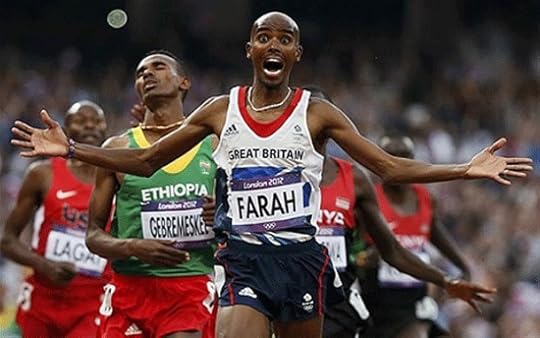 Yet this revelry ignored the questioning of identities that African immigrants routinely endure in British society. Following the events, renowned Somali author Nuruddin Farah was quoted as saying, “I wish [Mo Farah] were wholly ours; that we, Somalis had invested in him and given him all that which have made him a winner.” Does Mo’s victory mean the British are ready to embrace Mo Farah along with immigrants and their descendants as wholly British? What of those who cannot run so fast? (Photo by Olivier Morin.)
Yet this revelry ignored the questioning of identities that African immigrants routinely endure in British society. Following the events, renowned Somali author Nuruddin Farah was quoted as saying, “I wish [Mo Farah] were wholly ours; that we, Somalis had invested in him and given him all that which have made him a winner.” Does Mo’s victory mean the British are ready to embrace Mo Farah along with immigrants and their descendants as wholly British? What of those who cannot run so fast? (Photo by Olivier Morin.)
Besides its unabashed attacks on Palestinian civilians, the state of Israel severely tightened its immigration policies in 2012, deporting hundreds of African immigrants (like the man in the photo below), threatening to repatriate thousands more and coercing female Ethiopian immigrants in particular to accept birth control injections. In comments laden with white supremacist rhetoric, Prime Minister Netanyahu even went as far as calling African immigrants living in Israel “infiltrators”.
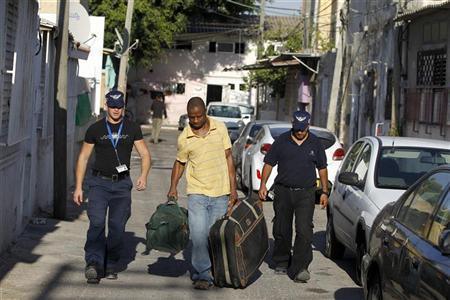 Many immigrants of African origin have lived in Israel for many years, some seeking greater economic opportunity and others fleeing from conflict. More than a few African immigrants subscribe to Jewish beliefs themselves, though perhaps even the converts don’t fit into the constructed vision of what Jewish people are supposed to be. But hey, at least European Jews have never migrated to other countries in search of refuge and economic prosperity. Oh, wait. (Photo by Baz Ratner.)
Many immigrants of African origin have lived in Israel for many years, some seeking greater economic opportunity and others fleeing from conflict. More than a few African immigrants subscribe to Jewish beliefs themselves, though perhaps even the converts don’t fit into the constructed vision of what Jewish people are supposed to be. But hey, at least European Jews have never migrated to other countries in search of refuge and economic prosperity. Oh, wait. (Photo by Baz Ratner.)
The illustrious life of South African President Jacob Zuma has been so inspiring to his citizens, that in 2012 Zuma was the muse for a provocative painting by artist Brett Murray. The piece in question, titled “The Spear”, depicted Zuma in a pose that mimicked propaganda images of Lenin in the Soviet Union, though with Zuma’s penis exposed. “The Spear,” along with other works in Murray’s exhibition (called Hail to the Thief II), represented a pessimistic commentary on governance under the African National Congress while portraying Zuma’s controversial lifestyle rooted in Zulu cultural tradition as misogynistic.
 As the South African public debated the freedom of expression, two men entered that exhibition’s gallery and defaced the painting (the unequal treatment of the two defacers, one black, one white, by gallery security is another issue entirely). To the dismay of the Zuma camp, this act only further elevated the portrait’s notoriety in the annals of South African art history. (Photo by Jerome Delay.)
As the South African public debated the freedom of expression, two men entered that exhibition’s gallery and defaced the painting (the unequal treatment of the two defacers, one black, one white, by gallery security is another issue entirely). To the dismay of the Zuma camp, this act only further elevated the portrait’s notoriety in the annals of South African art history. (Photo by Jerome Delay.)
After a few years of dithering, the UN’s science and cultural organization UNESCO finally embraced the abandonment of its dignity by awarding a science prize sponsored by the unscrupulous president of Equatorial Guinea, Teodoro Obiang Nguema Mbasogo. It mattered not that the longest serving president in Africa, in power since 1979, has been accused of corruption and human rights violations of epic proportions. Nor did it matter that his son Teodoro Nguema Obiang Mangue aka Teodorín, Minister of Agriculture and Forestry in his father’s government, has somehow amassed a fortune that has afforded him multi-million dollar estates in California and Paris on a modest government salary. The young Obiang’s questionable finances have led authorities in France to issue a warrant for his arrest and seize his $100 million dollar French estate (which had a $2 million wine collection).
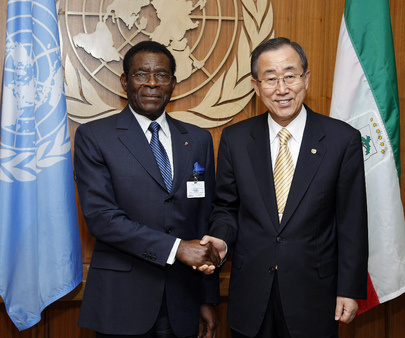 Based on the smile on UN Secretary General Ban Ki Moon’s face in the photo (by Eskinder Debebe) and the dissatisfaction on that of the elder Obiang, perhaps the dignity of the UN wasn’t worth as much as it was sold for.
Based on the smile on UN Secretary General Ban Ki Moon’s face in the photo (by Eskinder Debebe) and the dissatisfaction on that of the elder Obiang, perhaps the dignity of the UN wasn’t worth as much as it was sold for.
Just prior to presidential elections scheduled in Mali for April, soldiers staged a coup against the government of President Amadou Toumani Touré. Once in control of Bamako, the soldiers, led by Captain Amadou Sanogo, cited failure by the Touré regime to adequately equip them to confront the attacks by nomadic Touareg rebels plaguing the north of the country as their reason for taking power. Exploiting the moment of political chaos in Bamako, the nomadic Touareg rebel groups began seizing greater expanses of land until they had carved the country in two. This new territory, which included the city of Timbuktu, was to be called Azawad. Members of the National Movement for the Liberation of Azawad wave the new territory’s flag in the image (by Jemal Oumar) below.
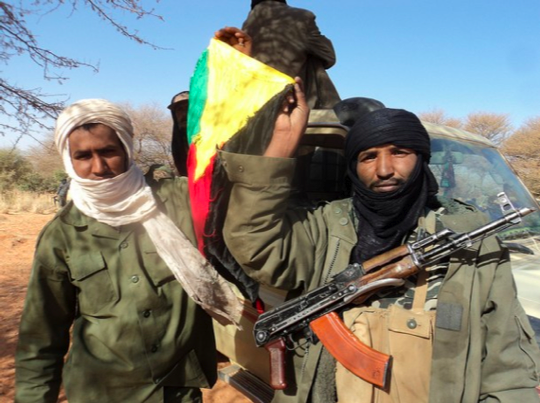 Since the creation of Azawad, non-Touareg ethnic groups have fled the region as pro-Azawad Islamist forces have attacked dissenters, banned non-Islamic music and destroyed mausoleums containing historically valuable, centuries-old texts. The Touaregs claim Azawad as their traditional pastoral grazing lands, yet other ethnic groups contest that they have lived there for generations. Regional body ECOWAS and the UN have threatened military intervention to reunify the country, yet so far no troops have been mobilized. How will the disputed nation of Azawad fare in 2013?
Since the creation of Azawad, non-Touareg ethnic groups have fled the region as pro-Azawad Islamist forces have attacked dissenters, banned non-Islamic music and destroyed mausoleums containing historically valuable, centuries-old texts. The Touaregs claim Azawad as their traditional pastoral grazing lands, yet other ethnic groups contest that they have lived there for generations. Regional body ECOWAS and the UN have threatened military intervention to reunify the country, yet so far no troops have been mobilized. How will the disputed nation of Azawad fare in 2013?
The battle for LGBT rights continued in Uganda in 2012, where the legislators vowed to pass a law criminalizing homosexuality with severe jail time. Supporters of the legislation maintain their claim that homosexuality is a foreign import that is contrary to “African tradition,” while critics of the bill have questioned just how the sexual orientation of gay Ugandans somehow prevents them from being African. Despite the threatening environment, brave Ugandans turned out for a gay pride rally that took place in August.
 Meanwhile, legislators have promised that the anti-gay bill has a 99% chance of passing. (Photo by David Robinson.)
Meanwhile, legislators have promised that the anti-gay bill has a 99% chance of passing. (Photo by David Robinson.)

10 Contested African Images of 2012
 Remember that little video campaign called #Kony2012? Yeah, we wish we could forget too. Few videos have reached the magnitude of pestilence that the non-profit Invisible Children’s video achieved this year. By transforming a complex regional crisis involving the Lord’s Resistance Army into a simple, manufactured (and in some ways factually false) narrative about the forces of good and evil, Jason Russell and his team at Invisible Children mobilized overeager teenagers like never before. Sharing the Kony 2012 video on Facebook and Twitter became akin to saving vulnerable African children from certain abduction. Activism had never been so easy. Amidst the cauldron of outrage, shock and disappointment stirred by the Kony 2012 video, Glenna Gordon released the photo above that further damaged the efforts of Russell and Co. to appear serious and altruistic. Invisible Children tried to embrace the image, calling it a joke, but the damage was done. The furor caused by the video mutated into deeper scrutiny and critical backlash, exposing IC’s ties to evangelical Christian organizations and leading the heroic Russell to have his infamous breakdown.
Remember that little video campaign called #Kony2012? Yeah, we wish we could forget too. Few videos have reached the magnitude of pestilence that the non-profit Invisible Children’s video achieved this year. By transforming a complex regional crisis involving the Lord’s Resistance Army into a simple, manufactured (and in some ways factually false) narrative about the forces of good and evil, Jason Russell and his team at Invisible Children mobilized overeager teenagers like never before. Sharing the Kony 2012 video on Facebook and Twitter became akin to saving vulnerable African children from certain abduction. Activism had never been so easy. Amidst the cauldron of outrage, shock and disappointment stirred by the Kony 2012 video, Glenna Gordon released the photo above that further damaged the efforts of Russell and Co. to appear serious and altruistic. Invisible Children tried to embrace the image, calling it a joke, but the damage was done. The furor caused by the video mutated into deeper scrutiny and critical backlash, exposing IC’s ties to evangelical Christian organizations and leading the heroic Russell to have his infamous breakdown.
In April, Swedish artist Makode Linde decided to bake a cake for an exhibition commemorating the 75th anniversary of the Swedish Artists’ National Organization. Linde, however, neglected to mention to the exhibition’s organizers that his gollywog-style cake, crafted in the shape of a black body would be alive (with Linde himself inside it). As soon as the exhibition’s guest of honor, Swedish Culture Minister Lena Adelsohn Liljeroth, cut into the cake it began to wail loudly. Finding humor in the cake’s pained cries, the Culture Minister proceeded to feed the cake to itself, leading to this image by Marianne Lindberg De Geer.
 Few if any of the event’s guests seemed to be troubled by the writhing, shrieking cake and on the contrary many reveled in cutting slices for themselves. The Minister was soon accused of racial insensitivity by the National Afro-Swedish Association, which called for her resignation. An interview with Makode Linde later revealed that the cake was intended to be part of his “Afromantics” series on black identity and cultural representation in Sweden and not a trap intended solely for the Minister. Whatever the artist’s intention was, Lindberg De Geer’s image bears testimony to that fact that sometimes an artwork can acquire greater social resonance than its creator ever intended.
Few if any of the event’s guests seemed to be troubled by the writhing, shrieking cake and on the contrary many reveled in cutting slices for themselves. The Minister was soon accused of racial insensitivity by the National Afro-Swedish Association, which called for her resignation. An interview with Makode Linde later revealed that the cake was intended to be part of his “Afromantics” series on black identity and cultural representation in Sweden and not a trap intended solely for the Minister. Whatever the artist’s intention was, Lindberg De Geer’s image bears testimony to that fact that sometimes an artwork can acquire greater social resonance than its creator ever intended.
Tension between mine workers, their employers and unions boiled over in South Africa this August as police were called in to quell miners striking against low wages and poor working conditions in a mine in Marikana owned by the London-based firm Lonmin. Toyi-toying for better living and working conditions is not uncommon in South Africa, but this time, when the dust settled, 34 miners lay dead, ridden with bullets. Many in South Africa were outraged at the horror of the police officers’ actions, many blamed the recklessness of the miners, many more barely batted an eyelid. The violence at Marikana presented South Africans with an opportunity to confront issues of lingering economic injustice, yet instead of embracing dialogue, the South African government thought it prudent to charge miners arrested in the unrest with the murder of their comrades.
 With few lessons learned from the tragedy at Marikana, black economic empowerment business tycoon and Lonmin board member, Cyril Ramaphosa, was elected to the position of Vice President of the governing ANC at the party’s recent conference in Mangaung. Was Ramaphosa’s connection to the deaths of the miners not a red flag? Without meaningful efforts to address South Africa’s woefully unequal wealth distribution, sadly, there could be more Marikanas to come. (Photo by Siphiwe Sibeko.)
With few lessons learned from the tragedy at Marikana, black economic empowerment business tycoon and Lonmin board member, Cyril Ramaphosa, was elected to the position of Vice President of the governing ANC at the party’s recent conference in Mangaung. Was Ramaphosa’s connection to the deaths of the miners not a red flag? Without meaningful efforts to address South Africa’s woefully unequal wealth distribution, sadly, there could be more Marikanas to come. (Photo by Siphiwe Sibeko.)
On January 1st 2012, the Nigerian government wished its citizens a happy new year by eliminating a subsidy on fuel prices dubbed “unsustainable” by the Governor of the Nigerian Central Bank, Sanusi Lamido Sanusi. The subsidy’s removal, favored by Nigerian president Goodluck Jonathan and Finance Minister Ngozi Okonjo-Iweala, caused fuel prices to jump by 120% practically overnight and led to increases in the cost of other essential goods. Fed up with the high cost of fuel in Africa’s largest oil producer and disillusioned with fiscal policy favoring elites, Nigerian citizens staged massive protests and strikes across the country. Angry protesters demanded a reinstatement of the subsidy and an end to corruption and financial mismanagement on the part of the Nigerian government. After two weeks of widespread protest, which became known as Occupy Nigeria, the Nigerian Government realized its maladroit political manoeuvring and reinstated the subsidy.
 As a postscript — In April 2012 American Jim Kim beat out Nigerian Finance Minister Ngozi Okonjo-Iweala in the contest for the World Bank presidency. Some Nigerians were dismayed not by Kim’s victory, but because Okonjo-Iweala’s defeat meant she would continue to be in a position to implement fiscal policy that could be damaging to the lives of Nigerian citizens. (Photo by Akintunde Akinleye.)
As a postscript — In April 2012 American Jim Kim beat out Nigerian Finance Minister Ngozi Okonjo-Iweala in the contest for the World Bank presidency. Some Nigerians were dismayed not by Kim’s victory, but because Okonjo-Iweala’s defeat meant she would continue to be in a position to implement fiscal policy that could be damaging to the lives of Nigerian citizens. (Photo by Akintunde Akinleye.)
In 2012, the Summer Olympics came to London. And while the Americans and the Chinese raced to the top of the medal tables, the British hosts struggled to win major events on their home turf. Enter Mo Farah, a Brit of Somali heritage, who represented Great Britain’s greatest hope to take gold in the high profile track races. With magical endurance and speed to match, Farah walked the walk and delivered gold medals in the 5,000 and 10,000-meter races to a roaring home audience. For this moment, the British people rejoiced in the victory they shared with Farah.
 Yet this revelry ignored the questioning of identities that African immigrants routinely endure in British society. Following the events, renowned Somali author Nuruddin Farah was quoted as saying, “I wish [Mo Farah] were wholly ours; that we, Somalis had invested in him and given him all that which have made him a winner.” Does Mo’s victory mean the British are ready to embrace Mo Farah along with immigrants and their descendants as wholly British? What of those who cannot run so fast? (Photo by Olivier Morin.)
Yet this revelry ignored the questioning of identities that African immigrants routinely endure in British society. Following the events, renowned Somali author Nuruddin Farah was quoted as saying, “I wish [Mo Farah] were wholly ours; that we, Somalis had invested in him and given him all that which have made him a winner.” Does Mo’s victory mean the British are ready to embrace Mo Farah along with immigrants and their descendants as wholly British? What of those who cannot run so fast? (Photo by Olivier Morin.)
Besides its unabashed attacks on Palestinian civilians, the state of Israel severely tightened its immigration policies in 2012, deporting hundreds of African immigrants (like the man in the photo below), threatening to repatriate thousands more and coercing female Ethiopian immigrants in particular to accept birth control injections. In comments laden with white supremacist rhetoric, Prime Minister Netanyahu even went as far as calling African immigrants living in Israel “infiltrators”.
 Many immigrants of African origin have lived in Israel for many years, some seeking greater economic opportunity and others fleeing from conflict. More than a few African immigrants subscribe to Jewish beliefs themselves, though perhaps even the converts don’t fit into the constructed vision of what Jewish people are supposed to be. But hey, at least European Jews have never migrated to other countries in search of refuge and economic prosperity. Oh, wait. (Photo by Baz Ratner.)
Many immigrants of African origin have lived in Israel for many years, some seeking greater economic opportunity and others fleeing from conflict. More than a few African immigrants subscribe to Jewish beliefs themselves, though perhaps even the converts don’t fit into the constructed vision of what Jewish people are supposed to be. But hey, at least European Jews have never migrated to other countries in search of refuge and economic prosperity. Oh, wait. (Photo by Baz Ratner.)
The illustrious life of South African President Jacob Zuma has been so inspiring to his citizens, that in 2012 Zuma was the muse for a provocative painting by artist Brett Murray. The piece in question, titled “The Spear”, depicted Zuma in a pose that mimicked propaganda images of Lenin in the Soviet Union, though with Zuma’s penis exposed. “The Spear,” along with other works in Murray’s exhibition (called Hail to the Thief II), represented a pessimistic commentary on governance under the African National Congress while portraying Zuma’s controversial lifestyle rooted in Zulu cultural tradition as misogynistic.
 As the South African public debated the freedom of expression, two men entered that exhibition’s gallery and defaced the painting (the unequal treatment of the two defacers, one black, one white, by gallery security is another issue entirely). To the dismay of the Zuma camp, this act only further elevated the portrait’s notoriety in the annals of South African art history. (Photo by Jerome Delay.)
As the South African public debated the freedom of expression, two men entered that exhibition’s gallery and defaced the painting (the unequal treatment of the two defacers, one black, one white, by gallery security is another issue entirely). To the dismay of the Zuma camp, this act only further elevated the portrait’s notoriety in the annals of South African art history. (Photo by Jerome Delay.)
After a few years of dithering, the UN’s science and cultural organization UNESCO finally embraced the abandonment of its dignity by awarding a science prize sponsored by the unscrupulous president of Equatorial Guinea, Teodoro Obiang Nguema Mbasogo. It mattered not that the longest serving president in Africa, in power since 1979, has been accused of corruption and human rights violations of epic proportions. Nor did it matter that his son Teodoro Nguema Obiang Mangue aka Teodorín, Minister of Agriculture and Forestry in his father’s government, has somehow amassed a fortune that has afforded him multi-million dollar estates in California and Paris on a modest government salary. The young Obiang’s questionable finances have led authorities in France to issue a warrant for his arrest and seize his $100 million dollar French estate (which had a $2 million wine collection).
 Based on the smile on UN Secretary General Ban Ki Moon’s face in the photo (by Eskinder Debebe) and the dissatisfaction on that of the elder Obiang, perhaps the dignity of the UN wasn’t worth as much as it was sold for.
Based on the smile on UN Secretary General Ban Ki Moon’s face in the photo (by Eskinder Debebe) and the dissatisfaction on that of the elder Obiang, perhaps the dignity of the UN wasn’t worth as much as it was sold for.
Just prior to presidential elections scheduled in Mali for April, soldiers staged a coup against the government of President Amadou Toumani Touré. Once in control of Bamako, the soldiers, led by Captain Amadou Sanogo, cited failure by the Touré regime to adequately equip them to confront the attacks by nomadic Touareg rebels plaguing the north of the country as their reason for taking power. Exploiting the moment of political chaos in Bamako, the nomadic Touareg rebel groups began seizing greater expanses of land until they had carved the country in two. This new territory, which included the city of Timbuktu, was to be called Azawad. Members of the National Movement for the Liberation of Azawad wave the new territory’s flag in the image (by Jemal Oumar) below.
 Since the creation of Azawad, non-Touareg ethnic groups have fled the region as pro-Azawad Islamist forces have attacked dissenters, banned non-Islamic music and destroyed mausoleums containing historically valuable, centuries-old texts. The Touaregs claim Azawad as their traditional pastoral grazing lands, yet other ethnic groups contest that they have lived there for generations. Regional body ECOWAS and the UN have threatened military intervention to reunify the country, yet so far no troops have been mobilized. How will the disputed nation of Azawad fare in 2013?
Since the creation of Azawad, non-Touareg ethnic groups have fled the region as pro-Azawad Islamist forces have attacked dissenters, banned non-Islamic music and destroyed mausoleums containing historically valuable, centuries-old texts. The Touaregs claim Azawad as their traditional pastoral grazing lands, yet other ethnic groups contest that they have lived there for generations. Regional body ECOWAS and the UN have threatened military intervention to reunify the country, yet so far no troops have been mobilized. How will the disputed nation of Azawad fare in 2013?
The battle for LGBT rights continued in Uganda in 2012, where the legislators vowed to pass a law criminalizing homosexuality with severe jail time. Supporters of the legislation maintain their claim that homosexuality is a foreign import that is contrary to “African tradition,” while critics of the bill have questioned just how the sexual orientation of gay Ugandans somehow prevents them from being African. Despite the threatening environment, brave Ugandans turned out for a gay pride rally that took place in August.
 Meanwhile, legislators have promised that the anti-gay bill has a 99% chance of passing. (Photo by David Robinson.)
Meanwhile, legislators have promised that the anti-gay bill has a 99% chance of passing. (Photo by David Robinson.)

The Top 10 Soundclouds of 2012
 Every few years my mode of music discovery changes. I went from browsing the racks of my local corporate music chain as a teenager, to digging for hours in the back rooms of second hand record shops, to scouring obscure blogs and doing random YouTube searches. This year marked another change in my listening habits as a more social media-oriented, web-mediated exchange with friends and fellow artists from around the world, has taken over my music research routine.
Every few years my mode of music discovery changes. I went from browsing the racks of my local corporate music chain as a teenager, to digging for hours in the back rooms of second hand record shops, to scouring obscure blogs and doing random YouTube searches. This year marked another change in my listening habits as a more social media-oriented, web-mediated exchange with friends and fellow artists from around the world, has taken over my music research routine.
The Soundcloud platform has taken on a central role in this transformation, as it has become a sort of default platform for the promo and first-exposure distribution of music from both major label and independent artists around the world. Importantly, this has facilitated my access to music scenes in lesser-represented countries, including many African nations which have been historically plagued by a lack of distribution infrastructure, and the presence of middle-(big) man distribution politics. Since any one platform’s monopoly on our mediated exchanges is dangerous, Soundcloud’s taking on this role in the global music production matrix isn’t absent of its crticisms. However, the platform has helped allow music fans to get a more raw, honest, and direct glimpse into individual artists’ creative processes.
I was a late adaptor to Soundcloud, but once the right people started uploading to the platform, it quickly took over as one of my main go-to sources for new music. So, especially for the DJ-inclined readers of Africa is a Country, here is a round up of my 10 favorite Soundclouders in 2012:
DJ Znobia - DJ Znobia has probably been my favorite producer and remixer for the last five years. I hadn’t heard anything from him for a while when I suddenly noticed him putting up a constant and daily stream of new songs on Soundcloud. The diversity of Angolan producers’ output is impressive. However, it’s Znobia who stands out, as a Lee “Scratch” Perry-esque experimenter, innovator, and genius of the scene.
Akwaaba Music - Benjamin Lebrave has come into his own as a jack of all trades in the promotion of African music. The label owner, journalist and DJ is constantly traveling to get the low-down of what’s happening at the current moment in various scenes. Beyond his label catalog, his many connections to producers across the continent and his constant liking and re-posts, have made him an all-star Soundclouder to follow.
Afropop Worldwide - Afropop Radio is archiving all of its past shows on Soundcloud. It is worth spending some time on their page and going through their back catalog, so you can catch up with classics like Siddhartha Mitter’s “Hip Hop Generation in Africa” piece.
DJ X-Trio - X Trio releases some really nice edits of up to the time pop tunes from around the world. A Deep House influenced production style dubbed “AfroFlava,” should see this Masters of Engineering degree holder personally pushing his sound to global dance floors in no time. Notable remixes that stayed in my DJ crates throughout the year were his versions of the Brazilian pop hit Nossa (Assim Voce Me Mata) and DJ Sbu’s Le Ngoma.
DJ Sliink - Alongside DJ Znobia, this guy is probably the most prolific remixer, producer, and Soundcloud uploader out there. A constant stream of his own tracks and mixes is accompanied by tracks culled from his peers and contemporaries in North New Jersey. His Soundcloud page is one of the best sources for playable, downloadable dance music around.
Deejay Kuimba DZC - Portugal is developing a pretty amazing electronic music scene, so it’s hard to choose just one of the many DJs I admire coming out of Lisbon and its surrounding areas. I don’t need to say more about Deejay Kuimba of the DZC DJs other than that he does the above.
Zuccony - This young Florida based producer’s remixes have been some of my best secret DJ weapons this year. His aggressive sound may not be for everyone, but he’s probably been the producer that has most made people to run up behind me while DJing to train-spot what I’m playing.
Sonora - Joseph Sonora Longoria, my good friend from San Antonio, is a prolific producer who experiments with everything from Cumbia to Crunk to House. Fans of contemporary African music will really appreciate his Zouk-love approximating “Amor de…” series. He is also the producer who got me back on to Soundcloud after I missed downloading one of his remixes, and vowed to never let it happen again.
Jumping Back Slash - I wasn’t too familiar with this South African DJ before this year, but his regular mention on OkayAfrica has pointed me to some really nice edits. Looking forward to seeing what else he comes up with in 2013.
Captain Planet - An end of the year discovery in terms of Soundclouding, but Charlie B. Wilder aka DJ Captain Planet had long been one of Brooklyn’s most solid DJs/diggers/remixers alongside the likes of Sabo and Uproot Andy. His now defunct Captain’s Crate blog was an early staple of my MP3 blogging days. Currently living in L.A., he has a slew of really impressive original songs as well as remixes on his Soundcloud page, referencing everything from Afrobeat to Chimurenga to Mayan Tribal Guarachero. Not on his own page, but worth the stream is his Madlib-inspired Mystery Trip Vol. 1 Mixtape.

The 10 Greatest Sporting Moments of 2012
 Next year we hope Nigerian super-pastor T.B. Joshua will let us know what 2013′s top 10 sporting moments will be well ahead of time (we’ll be starting our dedicated sports page “Football is a Country” in the new year and if Joshua wants to join in he’s more than welcome). While professional TV pundits cautiously offer that “whoever scores first has a great chance of winning” and other such banalities, and Gary Neville has recently been praised for his detailed dissection of defensive errors, all that is small fry for T.B. Joshua, who has the distinct advantage of being able to watch all major football matches ahead of time in the company of God the Father (that link shows him supposedly prophesying Zambia’s African Cup of Nations win). Just a shame he couldn’t be bothered with the Olympics. Here’s our rundown of 10 great moments in African sport from the year just past.
Next year we hope Nigerian super-pastor T.B. Joshua will let us know what 2013′s top 10 sporting moments will be well ahead of time (we’ll be starting our dedicated sports page “Football is a Country” in the new year and if Joshua wants to join in he’s more than welcome). While professional TV pundits cautiously offer that “whoever scores first has a great chance of winning” and other such banalities, and Gary Neville has recently been praised for his detailed dissection of defensive errors, all that is small fry for T.B. Joshua, who has the distinct advantage of being able to watch all major football matches ahead of time in the company of God the Father (that link shows him supposedly prophesying Zambia’s African Cup of Nations win). Just a shame he couldn’t be bothered with the Olympics. Here’s our rundown of 10 great moments in African sport from the year just past.
1. Chipolopolo bring the African Cup of Nations home
Stoppila Sunzu sang in unison with his team-mates behind him as he smashed in the penalty-kick that won Zambia the African Cup of Nations (skip to 17m 30s in the video above). Didier Drogba’s penalty miss and taunting by Zambian goalie Kennedy Mweene and 120 minutes of energy-sapping play brought Chipolopolo, massive underdogs before the tournament, to a penalty shootout they seemed fated to win, nineteen years on from the plane crash in Gabon that killed their great team of 1993 (this report from 1994 is worth watching). Days before the final the 2012 squad laid flowers at the scene of the crash. Spine-tingling stuff, and in what was generally a depressing year to be a football fan, Zambia’s victory gave us hope.
Here are all the goals they scored on their way to that night in Libreville; this was how Zambia’s great broadcaster Dennis Liwewe reflected on the triumph; and this is how the champions were welcomed home to Lusaka. It’s been an incredible year for Zambian football, and it ended in appropriate style — Christopher Katongo was named BBC African Footballer of the Year and Godfrey Chitalu’s all-time world record of 107 goals in 1972 came to global prominence.
2. David Rudisha wins Olympic 800m gold in a World Record 1:40:91
Just watch it again and enjoy. Botswana’s 18 year old Nijel Amos ran an incredible race in second, but he just couldn’t get near Rudisha, a man inspired that day, and one of the African continent’s all-time great Olympians.
3. Tiki Gelana and Stephen Kiprotich win the London 2012 Olympics marathons
Nobody who saw it will be able to forget the moment Stephen Kiprotich crossed the line to win the Olympic men’s marathon and Uganda’s first medal in forty years, his arms thrust aloft and the Ugandan flag streaming behind him. Kiprotich had simply blown the field away, just as Tiki Gelana had in the women’s event. She clocked up an Olympic record and yet another gold for Ethiopia’s distance runners.
4. Meseret Defar wins Olympic 5000m Gold
This was just a thrilling race, fought between some of the great female distance runners of the modern era. Meseret Defar surged past her great rival Tirunesh Dibaba down the home straight and held off a strong challenge from Kenya’s Vivian Cheruiyot to win back the Olympic title she’d first won in Athens in 2004. The post-race hug between the two Ethiopians gave us one of our favourite Olympic photos (see at the top of this post). Dibaba also had a great Olympics, retaining the 10,000m title she won in Beijing.
5. Taoufik Makhloufi’s astonishing 1500m Gold at London 2012
Makhloufi won this race in awesome fashion, charging to the front in the closing stages and simply elbowing his more celebrated rivals out of the way before drawing clear to win the race by a distance. Disqualified from the race for “not making a bona fide effort” in the 800m the day before, Makhloufi produced a doctor’s note saying he’d been injured and was reinstated for his favoured 1500m. He didn’t look very injured the next day, and the Algerian surged to a memorable victory.
6. Drogba’s Champions League Final
 Didier Drogba won the Champions League this year, thumping in an unstoppable 89th minute equaliser with his head, before slotting the winning penalty in the shootout. At last, this was “Drogba d’Europa“, as Italian sports daily Gazzetta dello Sport had it the next morning. Wrote Laurent Dubois at the time:
Didier Drogba won the Champions League this year, thumping in an unstoppable 89th minute equaliser with his head, before slotting the winning penalty in the shootout. At last, this was “Drogba d’Europa“, as Italian sports daily Gazzetta dello Sport had it the next morning. Wrote Laurent Dubois at the time:
There are some matches that end up seeming primarily the vehicle for one person to somehow attain mythical status. The Champions League final between Chelsea and Bayern was written, it seems now, purely to allow Didier Drogba a form of poetic catharsis worthy of fiction or film [...] Drogba, draped in an Ivory Coast flag, danced around the trophy on the pitch. But it was in the locker-room afterwards, we learned from The Sun, that he celebrated by transforming the trophy into an interlocutor, and his teammates into rapt (or so I imagine; though maybe they were chattering through the whole thing while itching themselves) spectators. It was a fifteen minute speech, during which Drogba excoriated the trophy for having eluded him for so long. He went through the details of the story: losses at Moscow and Barcelona, and all the matches of this campaign that had led to this moment. At one point he transformed the trophy into a sought-after lover who had spurned him for too long: “With the entire squad looking on, Drogba demanded to know why the trophy had been flirting with him for so long yet had always avoided him.” But in the end, he turned the trophy into a religious object, ending “his amazing 15-minute performance by bowing down to the cup and offering a prayer of thanks.”
Well done, Didier. Of course, T.B. Joshua knew all along that he’d do it (as long as his racist teammate John Terry didnt’ play) and so did his congregation.
7. Cabo Verde beat Cameroon
Look out, world. Cabo Verde are heading for their first ever African Nations Cup finals in 2013, after knocking out star-studded Cameroon in qualifying. Cameroon were so desperate after the first leg defeat that they managed to persuade Sammy Eto’o to return for the second game in Yaoundé. But Os Tubarões Azuis were resolute, and will be one of the teams to watch at next month’s competition.
8. Chad le Clos beats Michael Phelps (& Chad le Clos’s dad becomes world famous)
Sometimes it’s more fun watching the parents than the race. South African swimmer Chad le Clos pulled off an astonishing victory over Michael Phelps in the 200m butterfly, but it was his dad Bert that everyone was talking about. And Debbie Phelps, whose reaction at the end of the race (she thought her son had won as usual) produced one of the great gifs.
9. Papiss Cissé’s wondergoal vs Chelsea
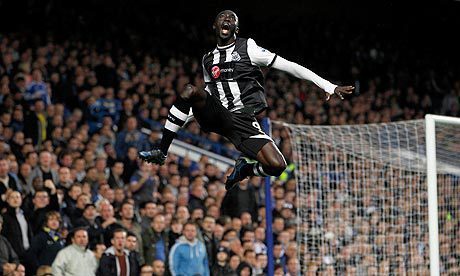 This goal was so good it inspired us to make a list of the greatest goals scored by African players in the English Premier League. Cissé’s effort came in fourth:
This goal was so good it inspired us to make a list of the greatest goals scored by African players in the English Premier League. Cissé’s effort came in fourth:
A goal so good it made hardened journeyman striker Steve Claridge throw up his hands and whimper with fear on live radio. The wow-factor of the goal lies in just how implausible it was, at the moment when Demba Ba chested the ball down for Papiss Demba Cissé (this manœuvre is now known as the “Double Demba”), that Cissé could possibly beat Petr Cech from a position wide out on the left wing by striking the ball with the outside of his right foot. But that’s exactly what he did.
10. South Africa (and Hashim Amla) rules world cricket
South Africa is the world’s number one cricket team after beating England and Australia back to back (on the road), and the star of the team is a bearded guy an Australian TV commentator once called a terrorist.
* Sean Jacobs also contributed to this post.

The 10 Greatest African Sporting Moments of 2012
 Next year we hope Nigerian super-pastor T.B. Joshua will let us know what 2013′s top 10 sporting moments will be well ahead of time (we’ll be starting our dedicated sports page “Football is a Country” in the new year and if Joshua wants to join in he’s more than welcome). While professional TV pundits cautiously offer that “whoever scores first has a great chance of winning” and other such banalities, and Gary Neville has recently been praised for his detailed dissection of defensive errors, all that is small fry for T.B. Joshua, who has the distinct advantage of being able to watch all major football matches ahead of time in the company of God the Father (that link shows him supposedly prophesying Zambia’s African Cup of Nations win). Just a shame he couldn’t be bothered with the Olympics. Here’s our rundown of 10 great moments in African sport from the year just past.
Next year we hope Nigerian super-pastor T.B. Joshua will let us know what 2013′s top 10 sporting moments will be well ahead of time (we’ll be starting our dedicated sports page “Football is a Country” in the new year and if Joshua wants to join in he’s more than welcome). While professional TV pundits cautiously offer that “whoever scores first has a great chance of winning” and other such banalities, and Gary Neville has recently been praised for his detailed dissection of defensive errors, all that is small fry for T.B. Joshua, who has the distinct advantage of being able to watch all major football matches ahead of time in the company of God the Father (that link shows him supposedly prophesying Zambia’s African Cup of Nations win). Just a shame he couldn’t be bothered with the Olympics. Here’s our rundown of 10 great moments in African sport from the year just past.
1. Chipolopolo bring the African Cup of Nations home
Stoppila Sunzu sang in unison with his team-mates behind him as he smashed in the penalty-kick that won Zambia the African Cup of Nations (skip to 17m 30s in the video above). Didier Drogba’s penalty miss and taunting by Zambian goalie Kennedy Mweene and 120 minutes of energy-sapping play brought Chipolopolo, massive underdogs before the tournament, to a penalty shootout they seemed fated to win, nineteen years on from the plane crash in Gabon that killed their great team of 1993 (this report from 1994 is worth watching). Days before the final the 2012 squad laid flowers at the scene of the crash. Spine-tingling stuff, and in what was generally a depressing year to be a football fan, Zambia’s victory gave us hope.
Here are all the goals they scored on their way to that night in Libreville; this was how Zambia’s great broadcaster Dennis Liwewe reflected on the triumph; and this is how the champions were welcomed home to Lusaka. It’s been an incredible year for Zambian football, and it ended in appropriate style — Christopher Katongo was named BBC African Footballer of the Year and Godfrey Chitalu’s all-time world record of 107 goals in 1972 came to global prominence.
2. David Rudisha wins Olympic 800m gold in a World Record 1:40:91
Just watch it again and enjoy. Botswana’s 18 year old Nijel Amos ran an incredible race in second, but he just couldn’t get near Rudisha, a man inspired that day, and one of the African continent’s all-time great Olympians.
3. Tiki Gelana and Stephen Kiprotich win the London 2012 Olympics marathons
Nobody who saw it will be able to forget the moment Stephen Kiprotich crossed the line to win the Olympic men’s marathon and Uganda’s first medal in forty years, his arms thrust aloft and the Ugandan flag streaming behind him. Kiprotich had simply blown the field away, just as Tiki Gelana had in the women’s event. She clocked up an Olympic record and yet another gold for Ethiopia’s distance runners.
4. Meseret Defar wins Olympic 5000m Gold
This was just a thrilling race, fought between some of the great female distance runners of the modern era. Meseret Defar surged past her great rival Tirunesh Dibaba down the home straight and held off a strong challenge from Kenya’s Vivian Cheruiyot to win back the Olympic title she’d first won in Athens in 2004. The post-race hug between the two Ethiopians gave us one of our favourite Olympic photos (see at the top of this post). Dibaba also had a great Olympics, retaining the 10,000m title she won in Beijing.
5. Taoufik Makhloufi’s astonishing 1500m Gold at London 2012
Makhloufi won this race in awesome fashion, charging to the front in the closing stages and simply elbowing his more celebrated rivals out of the way before drawing clear to win the race by a distance. Disqualified from the race for “not making a bona fide effort” in the 800m the day before, Makhloufi produced a doctor’s note saying he’d been injured and was reinstated for his favoured 1500m. He didn’t look very injured the next day, and the Algerian surged to a memorable victory.
6. Drogba’s Champions League Final
 Didier Drogba won the Champions League this year, thumping in an unstoppable 89th minute equaliser with his head, before slotting the winning penalty in the shootout. At last, this was “Drogba d’Europa“, as Italian sports daily Gazzetta dello Sport had it the next morning. Wrote Laurent Dubois at the time:
Didier Drogba won the Champions League this year, thumping in an unstoppable 89th minute equaliser with his head, before slotting the winning penalty in the shootout. At last, this was “Drogba d’Europa“, as Italian sports daily Gazzetta dello Sport had it the next morning. Wrote Laurent Dubois at the time:
There are some matches that end up seeming primarily the vehicle for one person to somehow attain mythical status. The Champions League final between Chelsea and Bayern was written, it seems now, purely to allow Didier Drogba a form of poetic catharsis worthy of fiction or film [...] Drogba, draped in an Ivory Coast flag, danced around the trophy on the pitch. But it was in the locker-room afterwards, we learned from The Sun, that he celebrated by transforming the trophy into an interlocutor, and his teammates into rapt (or so I imagine; though maybe they were chattering through the whole thing while itching themselves) spectators. It was a fifteen minute speech, during which Drogba excoriated the trophy for having eluded him for so long. He went through the details of the story: losses at Moscow and Barcelona, and all the matches of this campaign that had led to this moment. At one point he transformed the trophy into a sought-after lover who had spurned him for too long: “With the entire squad looking on, Drogba demanded to know why the trophy had been flirting with him for so long yet had always avoided him.” But in the end, he turned the trophy into a religious object, ending “his amazing 15-minute performance by bowing down to the cup and offering a prayer of thanks.”
Well done, Didier. Of course, T.B. Joshua knew all along that he’d do it (as long as his racist teammate John Terry didnt’ play) and so did his congregation.
7. Cabo Verde beat Cameroon
Look out, world. Cabo Verde are heading for their first ever African Nations Cup finals in 2013, after knocking out star-studded Cameroon in qualifying. Cameroon were so desperate after the first leg defeat that they managed to persuade Sammy Eto’o to return for the second game in Yaoundé. But Os Tubarões Azuis were resolute, and will be one of the teams to watch at next month’s competition.
8. Chad le Clos beats Michael Phelps (& Chad le Clos’s dad becomes world famous)
Sometimes it’s more fun watching the parents than the race. South African swimmer Chad le Clos pulled off an astonishing victory over Michael Phelps in the 200m butterfly, but it was his dad Bert that everyone was talking about. And Debbie Phelps, whose reaction at the end of the race (she thought her son had won as usual) produced one of the great gifs.
9. Papiss Cissé’s wondergoal vs Chelsea
 This goal was so good it inspired us to make a list of the greatest goals scored by African players in the English Premier League. Cissé’s effort came in fourth:
This goal was so good it inspired us to make a list of the greatest goals scored by African players in the English Premier League. Cissé’s effort came in fourth:
A goal so good it made hardened journeyman striker Steve Claridge throw up his hands and whimper with fear on live radio. The wow-factor of the goal lies in just how implausible it was, at the moment when Demba Ba chested the ball down for Papiss Demba Cissé (this manœuvre is now known as the “Double Demba”), that Cissé could possibly beat Petr Cech from a position wide out on the left wing by striking the ball with the outside of his right foot. But that’s exactly what he did.
10. South Africa (and Hashim Amla) rules world cricket
South Africa is the world’s number one cricket team after beating England and Australia back to back (on the road), and the star of the team is a bearded guy an Australian TV commentator once called a terrorist.
* Sean Jacobs also contributed to this post.

December 27, 2012
My Subjective List of The Best Albums of 2012

No, K’Naan’s “God, Country or the Girl” did not make my list of best albums of 2012. And his post-facto denouncement of its contents in an op-ed in The New York Times (!) has nothing to do with it. With the exception of a cut with Nas (“Nothing to Lose“), K’Naan’s album is an objective lesson in how not to organize an album. Too many aging rock star guests (Bono, Keith Richards), trying too hard for the chart-centered pop ballad (e.g. “Is Anybody Out There” with Nelly Furtado) and the “world music” feel of everything (in no fit of irony, he samples Paul Simon on one song). But on to better things. In no particular order.
 Alabama Shakes, “Boys & Girls.”Not every album on this list is music by African artists. Take Alabama Shakes. No one else comes close to commanding a stage like lead singer Brittany Howard (I saw them play in December last year at the Mercury Lounge in New York City). Every cut on this album deserves a mention, but I’ll single out the ones that made the earlier self-titled EP: “Hold on” (my single of 2012), “I found you,” “On your way” and ”You ain’t alone.”
Alabama Shakes, “Boys & Girls.”Not every album on this list is music by African artists. Take Alabama Shakes. No one else comes close to commanding a stage like lead singer Brittany Howard (I saw them play in December last year at the Mercury Lounge in New York City). Every cut on this album deserves a mention, but I’ll single out the ones that made the earlier self-titled EP: “Hold on” (my single of 2012), “I found you,” “On your way” and ”You ain’t alone.” Kendrick Lamar, “good kid, M.A.A.D. city.” Forget the hype, this is genius work from producer Dr Dre and Lamar.
Kendrick Lamar, “good kid, M.A.A.D. city.” Forget the hype, this is genius work from producer Dr Dre and Lamar. Laura Mvula, “iTunes Festival 2012.” After I heard her single”She” (there is a music video now), I had to hear more. I found she has an EP of 4 songs recorded live at the iTunes Festival. (I know this is strictly not an album, but it is my list.)
Laura Mvula, “iTunes Festival 2012.” After I heard her single”She” (there is a music video now), I had to hear more. I found she has an EP of 4 songs recorded live at the iTunes Festival. (I know this is strictly not an album, but it is my list.)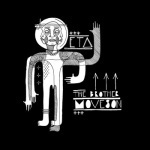 The Brother Moves On, “ETA.” New South African genre-busters. The next BLK JKS. Even The Guardian noticed.
The Brother Moves On, “ETA.” New South African genre-busters. The next BLK JKS. Even The Guardian noticed. Frank Ocean, “Channel ORANGE.” He “grew up in Sierra Leone.”
Frank Ocean, “Channel ORANGE.” He “grew up in Sierra Leone.”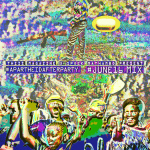 Spoek Mathambo, “#APARTHEIDAFTERPARTY #JUNE16, 2012.” If mixtapes were albums.
Spoek Mathambo, “#APARTHEIDAFTERPARTY #JUNE16, 2012.” If mixtapes were albums. Cody ChesnuT, “Landing on a Hundred.” This is a long way from “The Seed.” On the new album he also namechecks every African country (yes Facebook commenters we know it is a continent). Cody later apologized for not shouting out Mali.
Cody ChesnuT, “Landing on a Hundred.” This is a long way from “The Seed.” On the new album he also namechecks every African country (yes Facebook commenters we know it is a continent). Cody later apologized for not shouting out Mali. Christian Scott, “Christian aTunde Adjuah.” Some people claim jazz is over, that’s till they hear Scott, Soweto Kinch, Ambrose Akinmusire and Robert Glasper (who unfortunately tweeted some dumb comments about non-English rap recently).
Christian Scott, “Christian aTunde Adjuah.” Some people claim jazz is over, that’s till they hear Scott, Soweto Kinch, Ambrose Akinmusire and Robert Glasper (who unfortunately tweeted some dumb comments about non-English rap recently). Hemelbesem and Isaac Mutant, “DOUBLE STORY.” In the post-POC and Brasse vannie Kaap age, most people associate Afrikaans rap with Jack Parow’s playful costumed act or attention-seekers Die Antwoord’s freakshow. That’s till they’ve heard veteran rapper Isaac Mutant. On this album, Mutant, whose style reminds of Wu Tang Clan’s wordplay mixed with grime style, teams up with another Cape Town MC, Hemelbesem. Get your hands on it.
Hemelbesem and Isaac Mutant, “DOUBLE STORY.” In the post-POC and Brasse vannie Kaap age, most people associate Afrikaans rap with Jack Parow’s playful costumed act or attention-seekers Die Antwoord’s freakshow. That’s till they’ve heard veteran rapper Isaac Mutant. On this album, Mutant, whose style reminds of Wu Tang Clan’s wordplay mixed with grime style, teams up with another Cape Town MC, Hemelbesem. Get your hands on it. And Bruce Springsteen’s latest album. Rocky Ground.
And Bruce Springsteen’s latest album. Rocky Ground.

10 Albums You Might Have Missed This Year
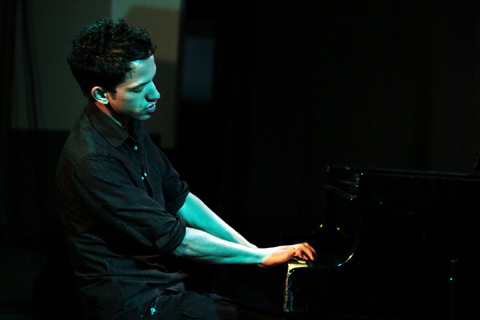
Kyle Shepherd (Photo by Ference Isaacs)
This list of 10 albums by African artists probably says more about my own musical preferences than it does about all those other “Best Albums of 2012″ year-end lists floating around on the web which didn’t include them (looking at you, Pitchfork, Stereogum, The FADER and SPIN). Not unlike last year, I’m surprised these albums don’t get more love on the net. My iTunes player tells me these were the recordings I’ve been listening to most this year — I got schooled while doing so too.
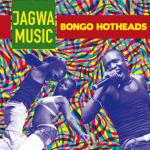 Jagwa Music – Bongo Heatheads
Jagwa Music – Bongo Heatheads
Quote: “Straight from Dar es Salaam, here’s Jagwa Music: a crew of 8 youngsters playing intricate grooves at breakneck speed on traditional & makeshift percussion, a keyboard player going wild on a battered vintage Casio, and three relentless front persons: two breathtaking, spectacular dancers & a charismatic lead vocalist/MC, belting out songs about survival in the urban maze, unfaithful lovers & voodoo.”
Watch and listen: Jagwa Music live in the streets of Dar.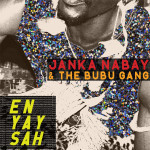 Janka Nabay & The Bubu Gang – En Yay Sah
Janka Nabay & The Bubu Gang – En Yay Sah
The similarities between the album cover art for Janka Nabay & The Bubu Gang and Jagwa’s are probably a coincidence but what both recordings do have in common is their drive. Sierra Leonean Janka Nabay and his American backing band delivered an awesome product.
Watch and listen: Somebody.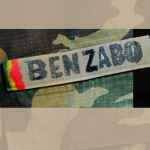 Ben Zabo
Ben Zabo
Quote: “His music is a string of firecrackers igniting on the dance floor of a midnight party. It is a music that has been perfected in the loud, sweaty, open-air clubs that line the outskirts of Bamako, places where the competition to get heard is fierce, and the chances of moving upward and outward are next to none. / This album is the first album ever to be released by a Malian of Bo descent.”
Watch and listen: Sènsènbo.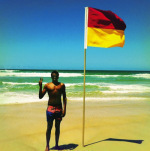 Sinkane
Sinkane
Quote: “New band of the day.”
For real though, Sudan-born Sinkane is Ahmed Gallab of Yeasayer (and many other bands).
Watch and listen: Runnin’. Youssoupha – Noir Désir
Youssoupha – Noir Désir
Youssoupha Mabiki is the son of Congolese legend Tabu Ley Rochereau.
Watch and listen: Les Disques de Mon Père (that’s “le père / the father,” 3:25 mins into the video).
Francophone African diaspora Hip-Hop speaking this much truth so eloquently — and so well-produced — about a nation’s ailing remains a rare thing.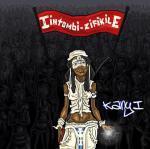 Kanyi – Lintombi Zifikile
Kanyi – Lintombi Zifikile
You know we admire South African rapper Kanyisa Mavi.
Watch (a 2011 video) and listen: Ingoma.
It’s tough, being a female MC out there. Kyle Shepherd – South African History !X
Kyle Shepherd – South African History !X
No other South African musician has been touring the world this year as widely as jazz artist Kyle Shepherd did. (Check his mad tour schedule; I’m still bummed he skipped his Belgian gig for a Swiss one.)
Quote: “paying homage to the languages of the first nation people…and bringing to the fore South Africa’s slave-holding past.”
Watch, listen, and take note: South African History !X. Ebo Taylor – Appia Kwa Bridge
Ebo Taylor – Appia Kwa Bridge
Quote: “Despite attending the same London music school as Fela Kuti in the early 1960s, this is only the second international release from Ghanaian highlife guitarist Ebo Taylor.”
Watch and listen: Ebo Taylor On Recording Appia Kwa Bridge. Francis Bebey – African Electronic Music 1975-1982
Francis Bebey – African Electronic Music 1975-1982
I wasn’t familiar with the work of late Cameroonian composer, musician, sculptor, novelist, guitarist, “Renaissance Man” and radio presenter Francis Bebey. Courtesy of French music label Born Bad.
Quote: “you’d be a fool to pass this up.”
Listen: Agatha.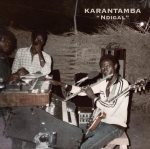 Karantamba – Ndigal
Karantamba – Ndigal
Teranga Beat released this extra-ordinary live recording (date: August 16, 1984; place: Sangomar Club, Thiès, Senegal) Gambian artist Bai Janha did with his last group, Karantamba, a school for young musicians.
Quote: “Band leader of the groups BLACK STAR, WHALES BAND, FABULOUS EAGLES & SUPREME EAGLES, founder of the group ALLIGATORS who later became the GUELEWAR, BAI is the one who created the unique psychedelic sound in the region of SENE-GAMBIA, mixing traditional compositions with Soul, his musical innovations contributed to the domination of AFRO-MANDING music in West Africa for more than a decade.”
Watch (older photo stills of the band) and listen: Satay Muso.

Sean Jacobs's Blog
- Sean Jacobs's profile
- 4 followers



